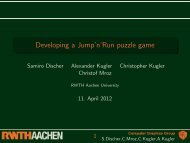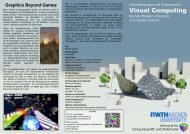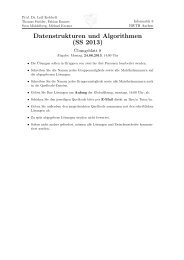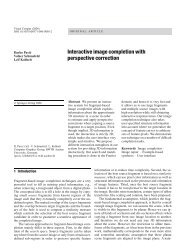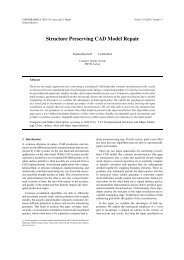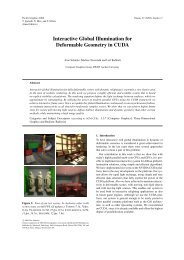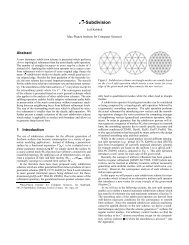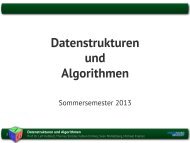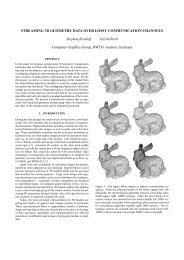Paper - Computer Graphics and Multimedia - RWTH Aachen ...
Paper - Computer Graphics and Multimedia - RWTH Aachen ...
Paper - Computer Graphics and Multimedia - RWTH Aachen ...
You also want an ePaper? Increase the reach of your titles
YUMPU automatically turns print PDFs into web optimized ePapers that Google loves.
M. Campen & M. Heistermann & L. Kobbelt / Practical Anisotropic Geodesy<br />
forward generalization of Lanthier’s concept to 3D grows<br />
quartically with the number of Steiner vertices per edge.<br />
7. Results<br />
In the previous sections we have discussed the qualitative<br />
differences of the approaches that are available for the computation<br />
of anisotropic distances. In order to get a quantitative<br />
underst<strong>and</strong>ing for the accuracy <strong>and</strong> runtime performance<br />
of all these options, we implemented all variants <strong>and</strong> performed<br />
extensive experiments using various kinds of input<br />
meshes (cf. Figure 10, 9K-183K triangles), metrics (vector<br />
field based as well as curvature tensor based), anisotropies<br />
(uniform as well as varying γ(x)), <strong>and</strong> algorithm parameters.<br />
The reference solutions we compare against have been<br />
computed using the edge-subdivision method of Lanthier<br />
[Lan99] with 200 Steiner vertices per edge (<strong>and</strong> runtimes<br />
of up to several hours for a single distance field). In this setting<br />
for every single triangle there are more than 120,000<br />
virtual edges crossing it, resulting in a highly accurate approximation<br />
of the true distances. We show the results using<br />
error-over-runtime plots in Figure 11 (<strong>and</strong> using error histograms<br />
in the supplemental material). Intuitively, the closer<br />
a method lies to the bottom left, the better – as this means<br />
that a low error (high accuracy) is achieved in a short time.<br />
These plots further allow to quickly see what other options<br />
apart from the “best one” are available, e.g. how much more<br />
accuracy can be achieved by spending how much more time.<br />
Regarding our STVD algorithm, we see that it lies in the<br />
bottom left region across the different levels of anisotropy,<br />
i.e. it achieves good results in short time when compared to<br />
the other options – especially for higher anisotropies. Good<br />
st<strong>and</strong>ard values for k can also be read from these plots: from<br />
around 5 for low anisotropy to around 10 for anisotropy 50.<br />
Note that such high anisotropy is not only of theoretical interest,<br />
e.g. anisotropies of 30+ have been used in [CBK12].<br />
For lower anisotropies, the Fast Marching method applied<br />
to the intrinsic Delaunay triangulation of a subdivided version<br />
of the input mesh is very competitive. Note that this<br />
strategy requires several steps of preprocessing: 1) mesh<br />
subdivision, 2) discrete metric computation, 3) reestablishing<br />
triangle inequality fulfillment, <strong>and</strong> 4) iDT construction.<br />
This also implies the drawbacks discussed in Sections 4.1<br />
<strong>and</strong> 4.2 <strong>and</strong> can take a considerable amount of (possibly<br />
Figure 10: Models used for the evaluation, depicted with example<br />
fields. (From the AIM@SHAPE repository, the Imagebased<br />
3D Models Archive, Télécom Paris, or created using<br />
Cosmic Blobs R○ by Dassault Systèmes Solidworks Corp.)<br />
amortizable) time. By contrast, STVD operates directly on<br />
the input mesh without the need for any preprocessing <strong>and</strong><br />
without implying additional complexity.<br />
When a higher level of accuracy is required <strong>and</strong> more<br />
time is available, the edge subdivision method of Lanthier<br />
[Lan99] proves to consistently provide a good option.<br />
In isotropic scenarios the advantage of STVD over, e.g.,<br />
Fast Marching or the Heat Method diminishes. However,<br />
we observed that it is typically still very significant when<br />
dealing with meshes with badly shaped elements. This is illustrated<br />
here on an example mesh (γ = 1), where the error<br />
(w.r.t. exact geodesic distances [SSK ∗ 05]) is visualized:<br />
12%<br />
9%<br />
6%<br />
3%<br />
0%<br />
8. Conclusion<br />
Dijkstra FM Heat<br />
(tuned time step)<br />
STVD<br />
(k =5)<br />
We have explored <strong>and</strong> discussed numerous options for<br />
the computation of distance fields with respect to general<br />
anisotropic metrics, based on generic as well as specific<br />
adaptations of known algorithms. We compared all these in<br />
terms of their accuracy <strong>and</strong> runtime performance <strong>and</strong> enriched<br />
this zoo of methods with our Short-Term Vector Dijkstra.<br />
Despite its simplicity, this method proved to provide<br />
a very interesting novel option, allowing to quickly compute<br />
results with practical accuracy without the need for complex<br />
optimization or costly preprocessing.<br />
In the future we would like to explore ways to enhance<br />
the smoothness of the results. Possibilities could be the use<br />
of averaging schemes during propagation [Sch13] or of a<br />
kind of “gradually fading memory” instead of a hard limit k.<br />
The use of a locally varying k (based on local feature size,<br />
anisotropy, mesh density) is another interesting direction.<br />
Acknowledgements Funding for this work was provided by<br />
the DFG Cluster of Excellence UMIC, grant DFG EXC 89.<br />
References<br />
[BC11] BENMANSOUR F., COHEN L. D.: Tubular structure segmentation<br />
based on minimal path method <strong>and</strong> anisotropic enhancement.<br />
Int. J. of <strong>Computer</strong> Vision 92, 2 (2011), 192–210.<br />
[BCLC09] BENMANSOUR F., COHEN L. D., LAW M. W. K.,<br />
CHUNG A. C. S.: Tubular anisotropy for 2d vessel segmentation.<br />
In CVPR (2009), pp. 2286–2293.<br />
[BPC08] BOUGLEUX S., PEYRÉ G., COHEN L. D.: Anisotropic<br />
Geodesics for Perceptual Grouping <strong>and</strong> Domain Meshing. In<br />
ECCV (2008), vol. 5303, pp. 129—-142.<br />
[CBK12] CAMPEN M., BOMMES D., KOBBELT L.: Dual Loops<br />
Meshing: Quality Quad Layouts on Manifolds. ACM Transactions<br />
on <strong>Graphics</strong> 31, 4 (2012), 110:1—-110:11.<br />
c○ 2013 The Author(s)<br />
c○ 2013 The Eurographics Association <strong>and</strong> Blackwell Publishing Ltd.



